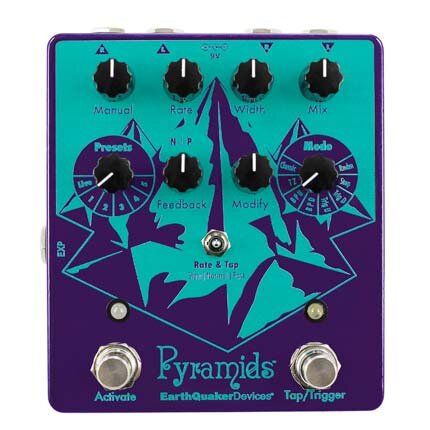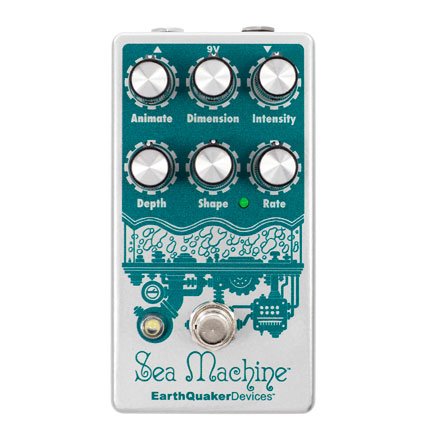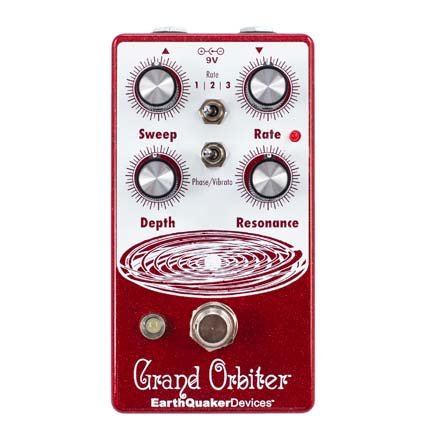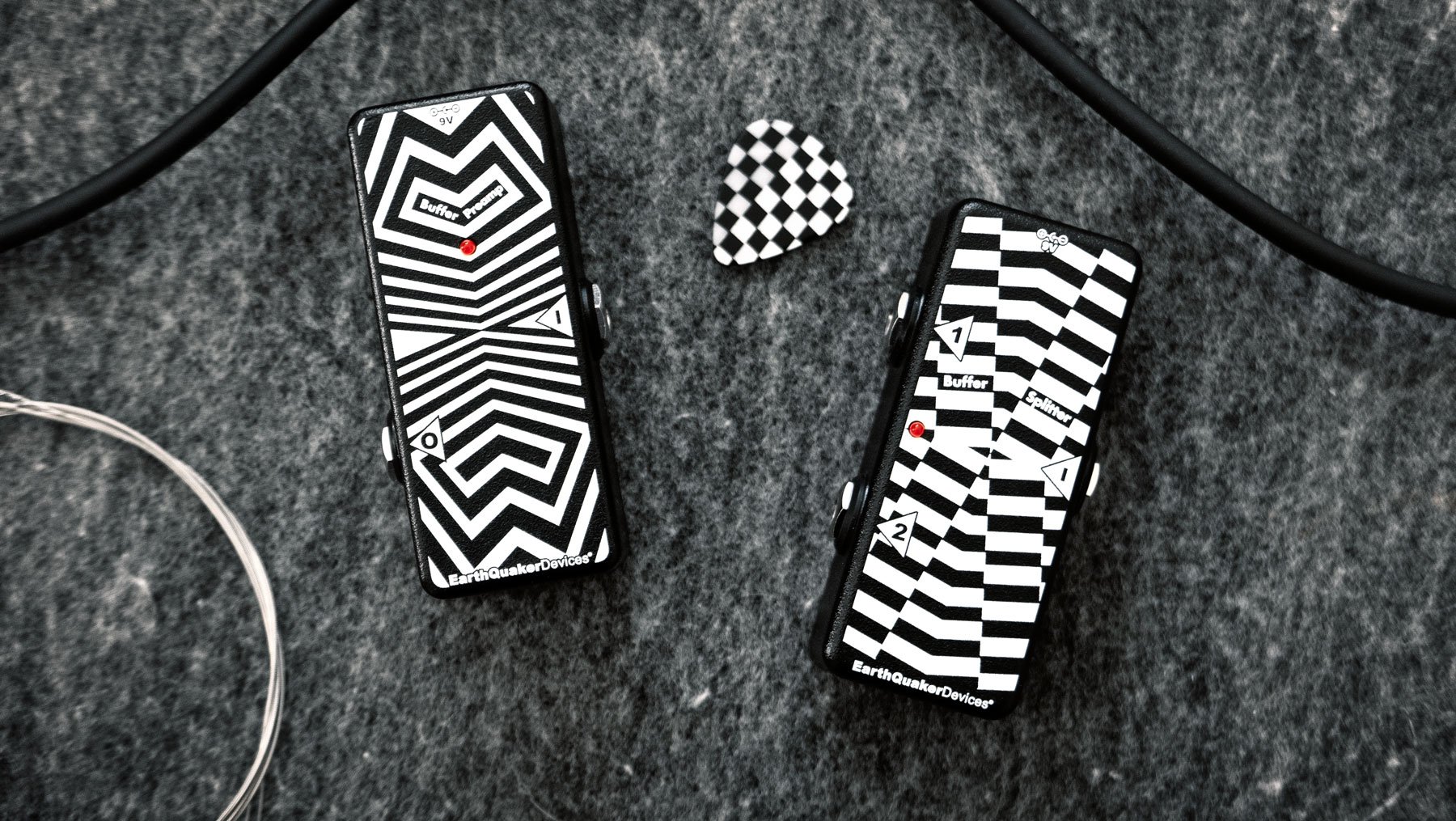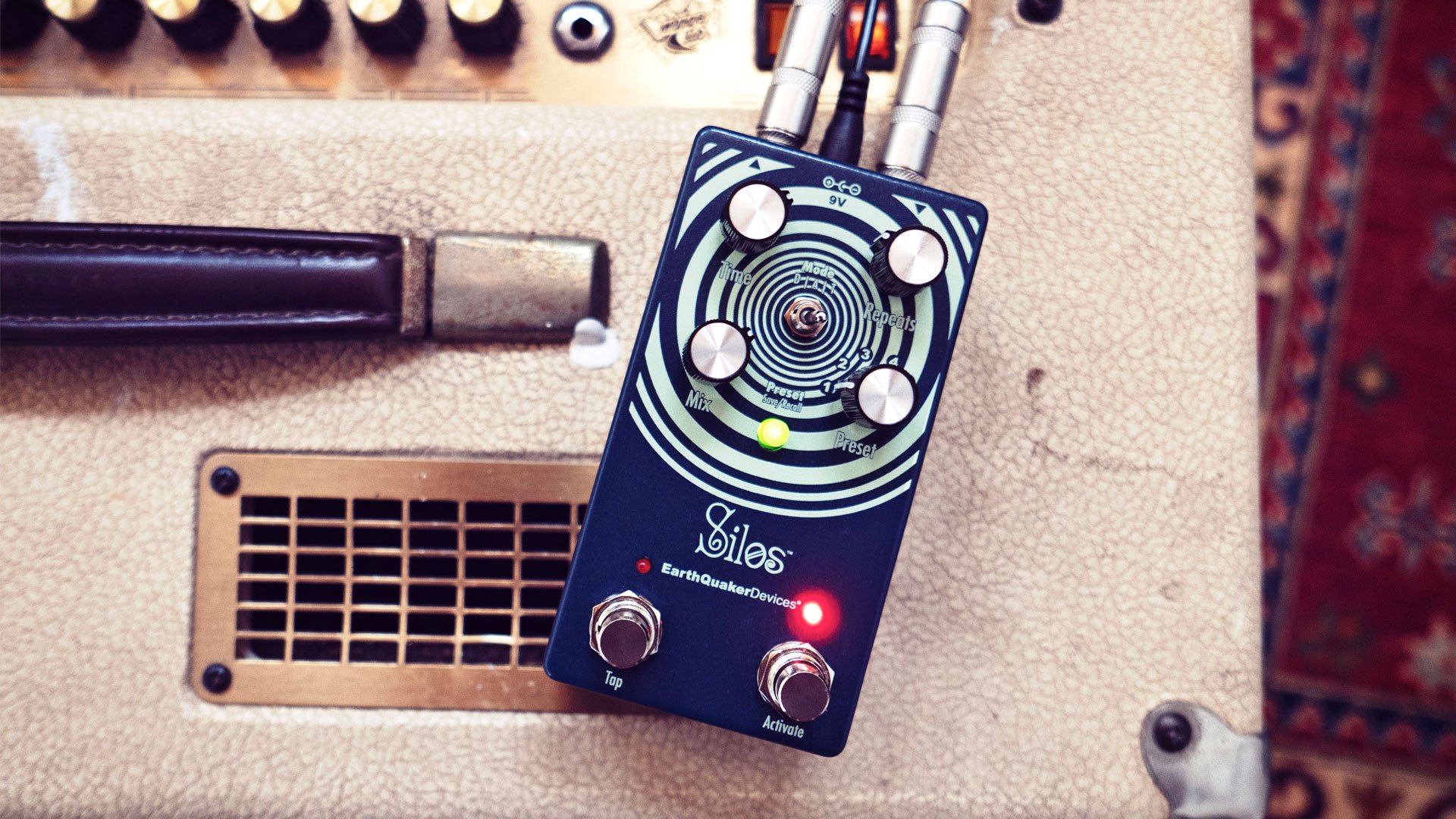The Great Modulator : A Guide To EarthQuaker Devices Modulation Pedals
Malcolm X Abram
Unlike other pedal categories, such as fuzz, delay, and reverb, modulation covers a lot of sonic ground and is arguably a creative free-for-all for adventurous circuit designers and players. Sure, your BM-based fuzz may be different from another BM-based fuzz. But they’re all building off the familiar big BM circuit.
While there are several famous chorus and phaser pedals, such as the Boss CE-2 and MXR Phase 90, there are also many insane pedals combining signal modulation with other delays, fuzz, and reverbs, such as the Mid-Fi Deluxe Pitch Pirate, The Fairfield Circuitry Shallow Water K-Field Modulator (a personal fave), and just about any modulation stompbox conjured up by Death By Audio.
EQD has eight modulation and filter pedals that are versatile and unique and can be used subtly for a dash of the effect, or you can crank ‘em up and get real weird. For this post, we’ll be focusing on the three modulation pedals: the Pyramids Stereo Flanging Device, the Sea Machine Super Chorus, and the Grand Orbiter Phase Machine.
And according to founder and lead designer Jamie Stillman, the EQD modulation pedals weren’t designed just to fill out the catalog alongside the ever-popular fuzzes and overdrives.
“Pretty much every modulation pedal I’ve designed had a plan in place before I sat down to work on it. There have been a few experimental discoveries on the way (Sea Machine, for example), but most of them have been very intentional from the start,” Stillman said.
“With the Pyramids, I knew I wanted to make a flanger with all the options I could ever want that mixed different aspects of the tones from my favorite vintage flangers (ADA, Ibanez FL305, Ibanez Airplane, Guyatone). I only wanted to make a super flanger one time, and the Pyramids was it. With dirt pedals, there are a lot more subtleties that can be tweaked, and the audience is much wider, so I feel like there is more room for dirt than modulation in the EQD line.”
If you are new to modulation pedals, it can be a bit confusing, particularly since modern integrated circuits (IC) and Digital Signal Processors (DSP, a.k.a fancy computer chips) such as Semiconductor’s wildly popular and programmable FV-1 chip, allow designers to cram several different kinds of modulation programs into a single pedal.
So here are a few basics that are good to know.
Phasers, flangers, and choruses can do similar sonic tricks to your signal but differ in how they do it. And, when their controls are manipulated, they can produce wildly different results.
Phasers work on frequency. First, it clones your signal one or more times, then puts the clones through one or more all-pass filters, also known as “stages,” that alter the length of each phase, known as phase shifting. Then it re-feeds all the signals back, giving you that cool swirly sound as the out-of-phase signals play together. Examples include John Bonham’s drums on “Kashmir,” David Gilmour's intro on “Have A Cigar,” “Nothing That Has Happened So Far Has Been Anything We Could Control” by Tame Impala, who likes to use phasers on the entire mix to great effect, and of course the late great Eddie Van Halen’s “Eruption.”
Flangers work on time delay, taking two signals and mixing them, and playing one signal back at a slower speed with an LFO (low-frequency oscillator) to modulate the timing of the delay, which gives that sweeping, whooshing effect. A few famous examples include Alex Lifeson’s intro to Rush’s “Spirit of Radio,” the opening GodRiff to Van Halen’s “Unchained,” and Nancy Wilson’s opening chug and throughout “Barracuda.”
Chorus works similarly to flangers, taking the signal and making an exact copy, then using a time delay to get the phasing effect, but the delay time used in the chorus effect is a bit longer. It’s nothing crazy; we’re just talking 20-50 milliseconds, giving the resulting effect a bigger sound than a flanger.
Chorus-drenched songs comprise a big chunk of late 70s and 80s pop, including Andy Summer’s tasty chords in The Police’s “Walking On The Moon” and a bunch of other songs by The Police. Andy ruled the chorus pedal in the late 70s and early 80s, along with nearly every post-punk band of the same era. Kurt Cobain’s famous riff from Nirvana’s “Come As You Are,” Wendy Melvoin’s tasty rhythm guitar in “Purple Rain,” and many of the clean guitar parts in Metallica songs, including “One,” are all good examples.
MEET THE PEDALS
Pyramids
EQD’s stereo flanging device has enough knobs, toggles, and footswitches to keep flange lovers in Flanger Heaven (a real place!). It’s got some treats you don’t see in many other flange pedals, including tap tempo, tap subdivision, a feedback control so you can mess with the flanged signal, eight different modes with a Modify knob that modifies each mode uniquely, and a variable mix control. Yeah, there’s a lot of subtle or wild and wacky stuff you can do. Did we mention it’s S-T-E-R-E-O?
Grand Orbiter
Anyone who has tried a few phasers knows that though they all do similar things, they all do them differently. The Grand Orbiter covers the basics and does pretty much everything else you could want from a phaser. It’s got two toggle switches. The first toggle features a slow rate, a fixed LFO setting that makes it a resonant filter, and a fast rate mode. The slow mode is really cool when you just want a touch of subtle movement. The other toggle turns the pedal into a vibrato. Yeah, two in one, baby! How’s that for value! Sweep controls the peak of the LFO sweep, Rate handles the speed within each toggle switch range, the Depth mixes the dry signal, and Resonance determines the amount of regeneration of the phased signal.
Sea Machine
Similar to a flanger, the chorus effect is not for everyone. For some, that classic chorus drenched arpeggiated guitar sound is dated. But the Sea Machine can give you more than just pop, new wave, and post-punk guitar and bass tones for your 70s and 80s party band. Sure, you can play all The Police, Boston, and The Fixx songs, but the Sea Machine can make your guitar signal sound seasick (get it?). It can give you those familiar chorus sounds from yore, or you can use its six knobs to get all warbly and wild.
PICTURES OF SOUND
To further explain how phasers, flangers, and chorus affect a signal, we’ve tapped EQD Design Engineer Matt “Lil’ Prez” Martin to give you some visual aids with help from an oscilloscope. Here are some notes from Matt so you know what you’re seeing in the following videos.
The yellow waveform is the pedal input
Purple waveform is the pedal output
Input waveform is a 500 Hz sine wave
The horizontal axis represents time: there are five milliseconds in between each grid line
The vertical axis represents voltage: there are 150 millivolts in between each grid line
Got it? Good. First up is the Grand Orbiter Phase Machine. These videos show you what each knob does to the signal. In each of the following four videos, one knob is being manipulated from fully counterclockwise to fully clockwise and back. All the other knobs are at noon, the rate is on position three (fast), and the lower switch is set to phase.
Depth Knob
Rate Knob
Resonance Knob
Sweep Knob
Pretty cool, huh? Now let’s move on to the Pyramids Stereo Flanging Device. Again with so many knobs and presets, Matt only gives us a taste of three of the most critical knobs: Feedback, Width, and Rate, along with presets one, two, and five for added information. In the Feedback video, the knob is being rotated from noon to fully clockwise (max feedback). In both the Rate and Width videos, the knob is being turned from fully counterclockwise to fully clockwise and back. The Modify and Mix knobs are at noon, the Rate knob is fully clockwise (fast), the pedal is in classic mode, and the rate and tap switch is set at normal speed.
Feedback Knob
Rate Knob
Width Knob
Preset 1
Preset 2
Preset 5
Audio science is fascinating, ain’t it? OK, last up is the Sea Machine Super Chorus. As with the other pedals, Matt manipulates a single knob at a time - Animate, Shape, Depth, and Rate - with the other knobs in nearly identical settings. In all four of the following videos, the Dimension knob is fully counterclockwise, the Intensity knob is at noon, and the Depth knob is fully clockwise. The Rate pot is at noon except for the Shape video, where it is at 9 o’clock. The manipulated knob is rotated from fully counterclockwise to fully clockwise and back.
Animate Knob
Depth Knob
Rate Knob
Shape Knob
Alright, now that you’ve absorbed the science, let’s hear all of that in action.
METHOD OF OUR MADNESS
Since this category is more varied than fuzz, we can’t quite make a strict side-by-side comparison because it’s kind of an apples to ribeye steak situation. Nevertheless, we would like to give you a sense of what they do to the same audio sample so you can choose which effect suits your musical needs. We’ve got our usual arpeggiated riffs and some chunky, lightly overdriven sounds, so you can really hear the filters and delays doing their respective things. For these audio clips, the staff at Upstairs Bedroom SoundLabs is using the pedals with a Jazzmaster style HSS guitar (we’re using the pretty tame bridge humbucker) through a Mooer Taxidea Taxus digital preamp. It then goes into the Twin Reverb 2X12 preset on the Mooer Radar Speaker Cab Simulator and into a Focusrite Scarlett 4i4 and Presonus Studio One 5 with just a hint of Waves TrueVerb plugin.
AUDIO!
There are way too many possible combinations of settings for us to cover here. Hell, the Pyramids alone has five presets and eight different modes. So, please head on over to the pedals’ respective product pages for deeper dives into their full capabilities. Hopefully, we can give you a general idea of the differences between the three to help you pick which one, two, or all three suits your needs. So, we will focus on the gentler side of each effect, show how turning one knob can wildly affect your results and highlight the differences in the types of effects.
Example #1 – Using the same quiet 8 bar chord progression, we start with the Phaser, Flanger, and Chorus pedals in subtle mode. Though the Depth and Rate knobs affect the signal differently on each pedal, we’ve got the rates on all pedals set at approximately quarter notes to approximate the audio clip's tempo and for a more consistent base sound.
First up is the Sea Machine chorus. For this clip, the settings are: Dimension knob, which adds some reverb resonance when turned clockwise, at noon. The Intensity knob, which adjusts the amount of the modulated signal blended with the dry signal, is also at noon, which is about unity. The Shape knob is turned fully counterclockwise to a triangle wave. Throughout the clip, we’ll turn the Animate knob which dictates how far the pitch-shifted signal swings. The first four bars are from zero to noon and then from noon to full during the last four. Trust us; you’ll hear the difference.
Next is the Pyramids flanger. Starting off with a gently effected signal in classic mode and the rate and tap toggle switch in fast mode. The Manual, Mix, and Rate knobs are at noon. We’ve set Width, which controls the LFO’s frequency sweep range at 9 o’clock to help you clearly hear how it works. Through the clip, we’ll be turning the Feedback knob which controls the regeneration of the modulated signal. At noon (there is a handy center-detent for accuracy), there is no feedback. First, we’ll turn counterclockwise for negative feedback, which has a more hollow sound, and then for the next four bars of the clip, we’ll turn clockwise into positive feedback, which gives us the famous (and infamous) flanging Whoooosh sound.
Finally, it’s our good buddy, the Grand Orbiter phaser and vibrato. As with its signal modulating siblings, the Depth knob, which blends the phase effect with the dry signal, is at noon, and the Sweep knob, which controls the frequency peaks of the LFO sweep, is fully cranked so you can hear it clearly. We’ll be turning the Resonance knob which controls the regeneration of the phase signal from zero (very subtle) to full (not subtle at all).
There you go! Thanks for making it to the end, and we hope this primer on phasers, chorus, and flangers has helped you understand the differences and similarities. If any of our pedals intrigue you, please don’t forget to check out their product pages for more audio and some video further explaining each pedal’s unique charms.
Malcolm X Abram is a recovering reporter and music writer and a proud 40 year guitar noodler. He lives, works and plays in the bucolic dreamland of Akron, Ohio in an old house with two dogs who don’t really like each other and way too many spiders.

